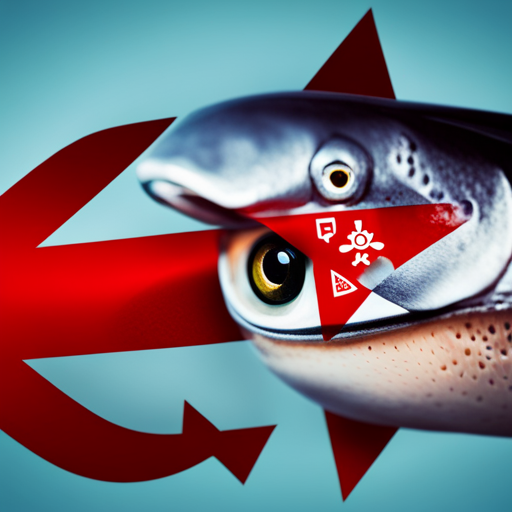Are you a fan of cod fish? It might be time to reconsider your love for this popular seafood.
Recent studies have found that wild caught cod is contaminated with per- and polyfluoroalkyl substances (PFAS), manmade compounds that have been linked to serious health concerns. In fact, the FDA tested samples of wild caught cod and found that 80% of them were contaminated with PFAS.
PFAS are known to be very stable, allowing them to accumulate in the bodies of people and animals. This accumulation has been linked to a range of health problems, including cancer, hormone disruption, and immune system dysfunction.
While the highest concentration of PFAS detected in the cod samples was less than the lowest FTAL limit, one serving of cod still contains about 37% of the weekly limit allowed by the European Food Safety Authority (EFSA).
So, what can you do to protect yourself from exposure to these harmful compounds? Keep reading to find out.
Key Takeaways
– Wild caught cod is commonly contaminated with PFAS, manmade compounds that can cause serious health problems.
– One serving of cod can contain a significant amount of PFAS, with levels exceeding the weekly limit set by the EFSA.
– PFAS can be found in nonstick cookware, food packaging, and firefighting foam, and can enter the body through contaminated food and water.
– Education and prevention are key in protecting oneself from PFAS exposure, including testing water regularly, avoiding fish caught in contaminated areas, and advocating for stricter regulations on PFAS use.
PFAS in Food
You should be aware that PFAS can be found in certain types of food, including wild caught cod, and can have serious health concerns if consumed in excess.
PFAS are manmade compounds that can be found in a variety of products, such as nonstick cookware, food packaging, and firefighting foam. These substances are very stable and can persist in the environment for a long time, which means they can also accumulate in the bodies of people and animals.
Dietary exposure to PFAS can occur through the consumption of contaminated food and water. The FDA tested wild caught cod and found PFAS contamination in 80% of the samples.
One serving of cod has 109 nanograms of PFAS, which is about 37% of the weekly limit allowed by the European Food Safety Authority (EFSA).
It’s important to be aware of the sources of PFAS in your diet and to take measures to reduce exposure, such as avoiding certain types of fish and using alternatives to nonstick cookware.
Health Risks
Eating contaminated seafood can lead to negative effects on your well-being. This is especially true when it comes to PFAS exposure. These manmade compounds are known to build up in the bodies of people and animals, and have been linked to serious health concerns such as cancer, reproductive and developmental problems, and immune system dysfunction.
Toxicity levels of PFAS in seafood, such as cod, are a growing concern. While the highest PFAS concentration found in cod is less than the lowest FTAL limit, one serving of cod can still contain about 37% of the weekly limit allowed by the European Food Safety Authority (EFSA).
It’s important to be aware of these risks and to take precautions when consuming seafood. This can include testing water regularly and avoiding fish caught in areas with known PFAS contamination. By taking these steps, you can help protect yourself from the negative health effects of PFAS exposure.
Prevention and Education
Educate yourself on the risks associated with consuming certain products and take steps to prevent exposure to harmful chemicals. When it comes to PFAS contamination in food, it’s important to be aware of both food safety and environmental safety.
While it’s crucial to avoid consuming contaminated fish and other products, it’s also important to take steps to prevent PFAS from entering the environment in the first place. This can include properly disposing of products containing PFAS, avoiding the use of non-stick cookware, and advocating for stricter regulations on PFAS use.
In addition to prevention, education is key in protecting oneself from PFAS exposure. By learning about the sources of PFAS contamination and the potential health risks associated with exposure, individuals can make informed decisions about what products to avoid and how to protect themselves.
This can include reading labels on food packaging, researching the PFAS content of products before purchasing, and staying up-to-date on the latest research and regulations related to PFAS. By prioritizing both education and prevention, individuals can take control of their own health and safety in the face of PFAS contamination.
Conclusion
Now that you’ve learned about the health concerns and contamination of PFAS in cod fish, it’s important to take action to protect yourself from exposure.
While avoiding contaminated fish altogether may seem like the easiest solution, it’s not always practical or possible.
Instead, focus on reducing your overall exposure to PFAS by being mindful of the products you use and the food you eat.
Start by reading product labels and avoiding items that contain PFAS. This includes non-stick cookware, waterproof clothing, and certain types of food packaging.
Additionally, try to eat a varied diet that includes a range of fish and seafood options, rather than relying solely on cod.
When you do eat cod, choose wild caught options over farmed, as these tend to have lower levels of contamination.
By taking these steps, you can help protect yourself and your family from the potential health risks associated with PFAS.
